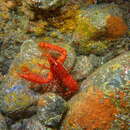Comprehensive Description
provided by Smithsonian Contributions to Zoology
Enoplometopus (Hoplometopus) antillensis Lütken, 1865
Enoplometopus antillensis Lütken, 1865:265.—Chace, 1966:634.—Debelius, 1986:13 [lower right color illustration].—Manning and Camp, 1989:412, figs. 1–4.
MATERIAL.—Grice Marine Biological Laboratory Collection: Sta 80–75, Hummock Point, 25 m: 1 male (GMBL).
Operation Origin: Site 29, South East Head, underneath boulder,25 m: 1 juvenile [10.8].
Other Collections: Jourdan (1977), Ascension Island, cave in 12 m: 2 males [39.0–43.8].—McDowell (1981), off South West Point 2 males [25.0–28.0], 1 ovig. female [25.7].— McDowell (1982), English Bay: 1 postlarva [6.8].—McDowell (1986), Ladies Loo: 1 male [35.2]; English Bay: 1 male [29.3].
SIZE.—Carapace lengdis of males, 25.0–43.8 mm; of ovigerous female,25.7 mm; of juvenile, 10.8 mm; of postlarva, 6.8 mm.
HABITAT.—The Ascension specimens were found in depths of 12 to 25 meters.
DISTRIBUTION.—Western Atlantic from Bermuda and south-eastern Florida to northeastern Brazil, eastern Atlantic from Madeira and the Gulf of Guinea; central Adantic from St. Helena and Ascension; to a depth of 201 meters.
- bibliographic citation
- Manning, Raymond B. and Chace, Fenner Albert, Jr. 1990. "Decapod and stomatopod crustaceans from Ascension Island, south Atlantic Ocean." Smithsonian Contributions to Zoology. 1-91. https://doi.org/10.5479/si.00810282.503

